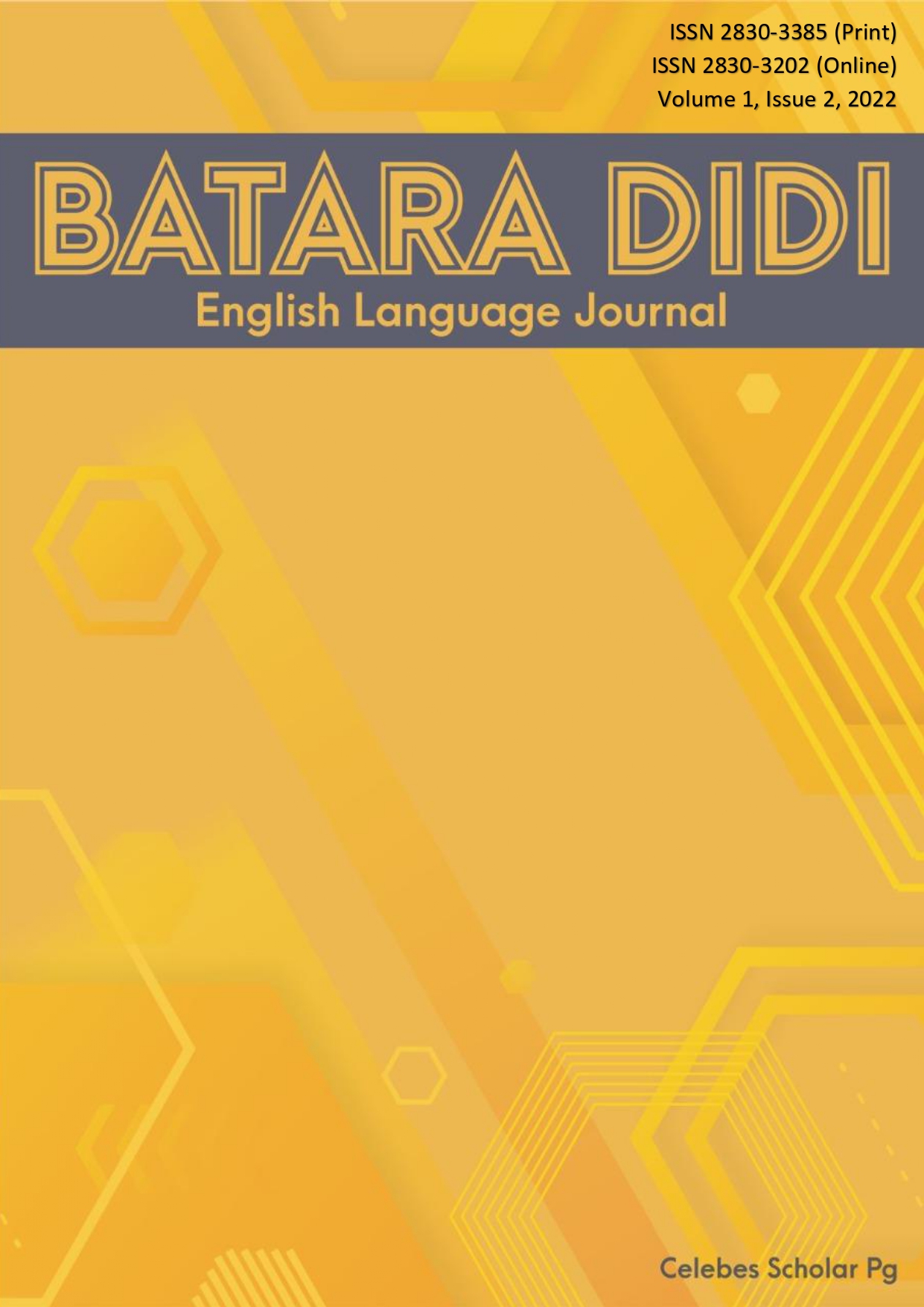The Analysis of Self-Regulated Learning in Improving Speaking Skills at the Classroom Context
Keywords:
Self-Regulated Learning, Speaking Skills, FluencyAbstract
This research aims to investigate how students self-regulated their learning in order to build their speaking abilities within the framework of a classroom setting. Since the majority of the study focuses on the relevance of speaking skills, this research is particularly relevant. This study examines how students may better themselves by self-regulating their learning to improve their speaking abilities in terms of smoothness or fluency in a classroom setting. In this particular study, the paradigm of quantitative research was used. The sample in this study was recruited from one of the junior high schools and totalled 33 students. The speaking test was the instrument used to gather the data. Based on the findings of the data, the students had a mean score of 71.66 on the pre-test assessment of their fluency (smoothness). While the post-test had a mean score that was higher than the pre-test, the post-test score for fluency was 81.06. Furthermore, the analysis of the data showed that the value of the t-test was more than the values in the t-test table (12.590 > 1.693). It indicated that there was a considerable disparity between them. Accordingly, it is possible to draw the conclusion that the implementation of Self-Regulated Learning was seen to be successful in improving the students' speaking abilities, particularly their fluency.
References
Aregu, B. B. (2013). Enhancing self-regulated learning in teaching spoken communication: does it affect speaking efficacy and performance?. Electronic Journal of Foreign Language Teaching, 10(1). http://e-flt.nus.edu.sg/
Aziz, A. A., & Kashinathan, S. (2021). ESL learners’ challenges in speaking English in Malaysian classroom. Development, 10(2), 983-991. 10.6007/IJARPED/v10-i2/10355.
Buitrago, A. G. (2017). Collaborative and Self-Directed Learning Strategies to Promote Fluent EFL Speakers. English Language Teaching, 10(5), 139-157. http://doi.org/10.5539/elt.v10n5p139
Chapman, G., & Campbell, R. (2016). The 5 Love Languages/5 Love Languages for Men/5 Love Languages of Teenagers/5 Love Languages of Children. Moody Publishers.
Chin, C., & Chia, L. G. (2004). Problem‐based learning: Using students' questions to drive knowledge construction. Science education, 88(5), 707-727. https://doi.org/10.1002/sce.10144
De Jong, N. H. (2018). Fluency in second language testing: Insights from different disciplines. Language Assessment Quarterly, 15(3), 237-254. https://doi.org/10.1080/15434303.2018.1477780
Gee, J. P. (2003). Opportunity to learn: A language-based perspective on assessment. Assessment in Education: Principles, Policy & Practice, 10(1), 27-46. https://doi.org/10.1080/09695940301696
Habermas, J. (1970). Towards a theory of communicative competence. Inquiry, 13(1-4), 360-375. https://doi.org/10.1080/00201747008601597
Loyens, S. M., Magda, J., & Rikers, R. M. (2008). Self-directed learning in problem-based learning and its relationships with self-regulated learning. Educational psychology review, 20, 411-427. https://doi.org/10.1007/s10648-008-9082-7
MacIntyre, P. D., Burns, C., & Jessome, A. (2011). Ambivalence about communicating in a second language: A qualitative study of French immersion students’ willingness to communicate. The Modern Language Journal, 95(1), 81-96. https://doi.org/10.1111/j.1540-4781.2010.01141.x
Mahjoob, E. (2015). Self-regulation and speaking proficiency in Iranian EFL learners. Journal of Language, Linguistics and Literature, 1(6), 182-188. http://www.aiscience.org/journal/j3l
Malley, O., & Pierce, L. V. (1996). Authentic assessment for English language learners. America: Addison-Wesley Publishing Company.
McGrew, S., Breakstone, J., Ortega, T., Smith, M., & Wineburg, S. (2018). Can students evaluate online sources? Learning from assessments of civic online reasoning. Theory & Research in Social Education, 46(2), 165-193. https://doi.org/10.1080/00933104.2017.1416320
Novita, E. (2019). The Use of Self-Regulated Strategy Development to Improve the Second Grade Students’ Writing Ability on Analytical Exposition at MAN 3 Blitar. Tulungagung: Institut Agama Islam Negeri.
Öztürk, M., & Çakıroğlu, Ü. (2021). Flipped learning design in EFL classrooms: implementing self-regulated learning strategies to develop language skills. Smart Learning Environments, 8(1), 2. https://doi.org/10.1186/s40561-021-00146-x
Renandya, W. A., Hamied, F. A., & Nurkamto, J. (2018). English language proficiency in Indonesia: Issues and prospects. Journal of Asia TEFL, 15(3), 618. http://dx.doi.org/10.18823/asiatefl.2018.15.3.4.618
Richards, J. C. (2005). Communicative language teaching today. Singapore: SEAMEO Regional Language Centre.
Rum, E. P., Garner, M., & Basri, M. Lecturers’ Approaches to Developing Students’ Interpersonal Communication Skill in Indonesian EFL Classroom. Asian EFL Journal. 27(4): 291-308
Shahini, G., & Shahamirian, F. (2017). Improving English Speaking Fluency: The Role of Six Factors. Advances in Language and Literary Studies, 8(6), 100-104. doi:https://doi.org/10.7575/aiac.alls.v.8n.6p.100
Zimmerman, B. J. (1989). A social cognitive view of self-regulated academic learning. Journal of educational psychology, 81(3), 329. https://doi.org/10.1037/0022-0663.81.3.329.
Downloads
Published
Issue
Section
License
Copyright (c) 2023 BATARA DIDI : English Language Journal

This work is licensed under a Creative Commons Attribution-ShareAlike 4.0 International License.
Articles of the BATARA DIDI : English Language Journal are licensed under
https://creativecommons.org/licenses/by/4.0.






